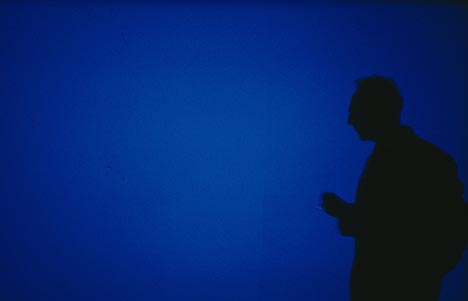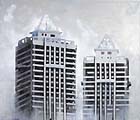
translated and summarized by: Liz Wollner-Grandville,
English summary August 2008
Secession: Thomas Hirschhorn – The Eye
Blood, consumption, and ideology
The Secession in Vienna is currently showing Thomas Hirschhorn’s installation “The Eye”. The dominating theme of his exhibition is the colour red: red as a symbol for blood and raw meat, for a national colour, for coca-cola packaging material – synonyms for life and violent death, nationalism, and global consumer imperialism. Movable walls are covered with press clippings and photos, all depicting something connected to blood or death: “the eye does not see everything – but it sees all that is red” (Hirshhorn).
Slain baby seals, victims of violence, war and terrorism, diverse flags and all sorts of things positioned throughout the exhibition space, which refer to the global omnipresence of red: traffic signs, hearts made of carton, anatomical models with blood vessels painted onto them or globes stained with blood, everything red effectively presented against a white background. Documentations showing victims of unbelievably brutal violence are positioned in contrast to blind consumerism and bland voyeurism. Something everyone should reflect on.
“Art develops from outrage” Hirschhorn wrote in an email to a NZZ journalist in 2002. The politically dedicated installation “The Eye”, with its special and accessible model of a world, which is dominated by the symbolic power of the colour red, is reflected by its content and is at the same time visually overwhelming.
Secession
1010 Vienna, Friedrichstrasse 12, until 04. 09. 2008
www.secession.at
Kunsthalle Wien: Derek Jarman – Brutal Beauty
Julien’s Jarman
One of the quotes included in Derek Jarman’s film “Blue” is: "the image is a prison of the soul”. Scratching the screen as if it were a prison wall, taking picture series apart and placing the unexpected in between, challenging the prison of the soul with every blink of the eye: Derek Jarman’s (1942 – 1994) art is a depressive firework, a celebration of homosexual identity and sexuality, romantic anti-Thatcherism. Imagine Van Gogh’s blue “Prisoners exercising” as a House party during the last 80s.
Derek Jarman studied art and painted until his early AIDS death, but it was his filmmaking talent that made him famous. His portraits of Caravaggio (1986) and Wittgenstein (1993) are legendary. The visually stunning poetics of “The Last of England”, in which he attempted to get even with the conservative-neoliberal model Thatcher, influenced many artists.
Among them the filmmaker and artist Isaac Julien. He curated the exhibit and also contributed some of his own works. Julien’s documentary “Derek” (2008) originated from an interview with Jarman, based on the text and sound of Tilda Swinton, one of Jarman’s favourite actresses, and uses original cuttings form Jarman’s films. The exhibit is arranged around this film and Jarman’s last movie “Blue”. Jarman’s movies are presented in a dark hall with ten flat screens, and the onlooker is left with no choice but to watch the entire spectrum. Naturally this type of presentation does not allow concentrating on a single film. However, the exhiibit's goal of emphasizing the closeness of painting and filmmaking is definitely achieved.
Kunsthalle Wien
1070 Vienna, Museumsplatz 1, until 05. 10. 2008
www.kunsthallewien.at
Manifesta 7
An introduction
The seventh edition of the Manifesta, the European Biennial of Contemporary Art, changes its location every two years and has now arrived in the Italian provinces of Trentino-South Tyrol. For the first time these exhibitions were designed for an entire region spanning 150 kilometres in the regions of Rovereto, Trentino, Bolzano, and Fortezza.
Considering the vast number of positions (180) and participants (230) one can easily imagine the enormous effort that was necessary to organize this event. In addition, the EU-supported organisation had to cope with the aftermath of the cancelled Manifesta 6 in Nicosia.
The international team of curators consisting of Adam Budak, Anselm Franke, Hila Peleg, and Monica Narula, Jeebesh Bagchi and Shuddhabrata Sengupta from the Raqs Media Collective as well as many others, designed a network of coherent and exciting exhibition situations with numerous thematic focal points. However, one aspect remained somewhat underexposed.
In a region which used to be the centre of European worker migration and which is characterized by buildings and monuments dating back to Mussolini Faschism, the chance to dock to social and historically relevant aspects was more or less neglected. Contrary to similar large events like the Istanbul Biennial, the Manifesta 7 staged itself apolitically. In a country, in which the debate regarding racist connotations was only recently sparked off on account of Romany children being fingerprinted for registration purposes, this is quite remarkable.
However, the presentation of the historical, architectural, and strategic importance of the fortress in Fortezza constitutes an exception. Texts written by 10 authors concentrate on the fortress, which was built as a stronghold against Napoleonic troops. Audio stations allow the visitors to critically reflect on this warlike symbol, which was never employed for its intended purpose and has now been made accessible to the public. The contributions were, among others, made by Mladen Dolar, Thomas Meinecke, Saskia Sassen, Reneé Green or Margareth Obexer.
The audio stations will remain even after the Manifesta 7 has been dismantled in the fall.
The other Manifesta stations are also more than worthwhile visiting. Visitors should be ready to spare at least two days to indulge in the widespread exhibition, and don't forget to take your critical "dissecting instrument” along.
Exhibitions take place at the following venues:
Rovereto: Manifattura Tabacchi, Ex Peterlini
Trento: Palazzo del Poste
Bolzano: Ex Alumix
Fortezza: fortress
Manifesta 7
Fortezza, Bolzano, Trentino, Rovereto, until 02. 11. 2008
www.manifesta7.it
Strabag Kunstforum: Felix Malnig – Ghost Town
Superficial criticism
The Strabag Artlounge is a typical example of a modern “business building” – cool, discrete, glass exterior walls, offering a view over the city of Vienna. The oeuvre created by the 1967 born artist presented within the framework of the Strabag Art Awards exhibit is just as nondescript as the building itself. His work is obviously well handcrafted, but neither especially elaborate nor painted with a personal touch.
The exhibited paintings of buildings and landscapes, which are completely devoid of people, equal a style of painting, which is completely devoid of ideas. The work therefore does not allow the onlooker to attain a deeper insight into architecture and consequently does not allow him/her to deal with it in a critical manner.
By attempting to criticize superficiality by working just as superficially is a form of criticism, which itself inevitably remains superficial.
Strabag Kunstforum
1220 Vienna, Donau-City Strasse 9, until 04.09.2008
www.strabag-kunstforum.at
Mehr Texte von translated and summarized by: Liz Wollner-Grandville


 Teilen
Teilen




